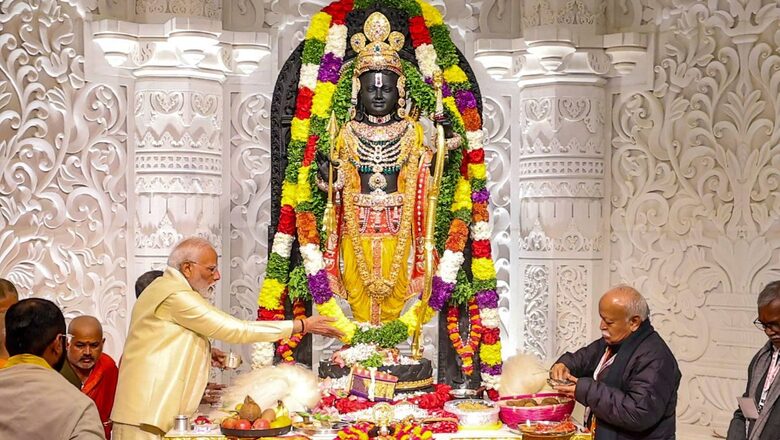
views
In a historic moment, the Pran Pratishtha of Ram Mandir on January 22, 2024, marks the realisation of a 500-year-old dream, a testament to faith, cultural strength, and the visionary leadership of Prime Minister Narendra Modi. This article explores the historical importance of Ram Mandir, the rituals surrounding the Pran Pratishtha, and Prime Minister Modi’s pivotal role in bringing this cherished dream to fruition. Additionally, it delves into the nationwide celebration and unity as the nation comes together in various ways to commemorate this significant occasion.
The Ram Mandir in Ayodhya holds unparalleled historical reverence, tracing its origins back to a 500-year-old dream cherished by millions. As the sacred Pran Pratishtha ceremony unfolds on January 22, it signifies not just the inauguration of a temple but the revival of an ancient cultural heritage. This event resonates deeply with the collective consciousness of the nation, symbolising the restoration of a cherished legacy.
The Pran Pratishtha ceremony is the consecration of the deities within the temple, breathing life into the sacred idols. On this auspicious day, priests perform intricate rituals, invoking divine blessings and ensuring that the temple becomes a sanctum of spiritual energy. The significance of this ceremony extends beyond religious boundaries, embodying the spirit of unity and shared cultural values.
At the core of the realisation of this historic dream is the visionary leadership of Prime Minister Narendra Modi. His steadfast commitment to the construction of the Ram Mandir reflects a profound understanding of the cultural tapestry that binds the nation together. Furthermore, under the leadership of PM Modi, Ayodhya has witnessed significant economic development. The construction of the Ram Mandir has not only fulfilled a long-standing cultural and religious aspiration but has also acted as a catalyst for economic progress in the region.
The government, under PM Modi’s vision, has implemented various initiatives to boost infrastructure, tourism, and overall economic growth in Ayodhya. The establishment of the Ram Mandir has attracted pilgrims and tourists from across the country, contributing to the local economy. Additionally, the associated development projects have created employment opportunities, further enhancing the socio-economic landscape of Ayodhya. Prime Minister Modi’s commitment to balancing cultural heritage with economic development reflects a comprehensive approach to nation-building, ensuring that Ayodhya reaps the benefits of both spiritual significance and economic prosperity.
The construction of the Ram Mandir faced numerous challenges over the years, including legal complexities and societal debates. The role of the then Chief Justice of India, Ranjan Gogoi, in the Ayodhya Ram Mandir case was crucial and marked by a commitment to upholding justice and delivering a historic judgement. Chief Justice Gogoi presided over a five-judge bench that heard the complex and emotionally charged case involving the title dispute over the Ayodhya land. Under his leadership, the Supreme Court conducted extensive hearings, considering arguments from all parties involved. Chief Justice Gogoi played a key role in steering the proceedings towards a mediated resolution.
The judgement, delivered on November 9, 2019, ruled in favour of the construction of a Ram Mandir at the disputed site, while also ensuring the allocation of an alternative plot for the construction of a mosque. His efforts in navigating this sensitive case demonstrated a commitment to justice, religious harmony, and the legal principles essential for resolving long-standing disputes.
The Pran Pratishtha of the Ram Mandir is not merely a religious event but a celebration resonating across the nation. People from diverse backgrounds join together in joyous celebration, transcending religious and cultural boundaries. Streets are illuminated, and cities echo with the sounds of bhajans and hymns. The unity is palpable as citizens, irrespective of their backgrounds, participate in various ways to mark this historic occasion. In various regions, people are organising community feasts, sharing traditional sweets, and adorning their homes with diyas and rangoli. Cultural events showcasing the rich heritage of India are being organised, allowing people to reconnect with their roots. Artists and performers express their joy through music and dance, creating a vibrant tapestry of celebration. Social media is abuzz with positive messages, with individuals sharing their thoughts, experiences, and expressions of joy using hashtags dedicated to the occasion. Virtual celebrations connect people from different parts of the country, fostering a sense of oneness.
In conclusion, the Pran Pratishtha of the Ram Mandir on January 22 marks the culmination of a 500-year-old dream, an event of profound cultural and historical significance. Prime Minister Narendra Modi’s visionary leadership has played a pivotal role in turning this dream into reality, showcasing a commitment to cultural heritage, unity, and economic progress. As the temple stands tall, it becomes a symbol of faith, resilience, and the enduring spirit of a nation that cherishes its past while forging ahead into a harmonious future. The nationwide celebration and unity witnessed in various expressions of joy underscore the collective pride and shared values defining the essence of India.
The author is Advocate Ashutosh Mishra, Managing Partner, Nyaayam Associates. Views expressed in the above piece are personal and solely that of the author. They do not necessarily reflect News18’s views.




















Comments
0 comment